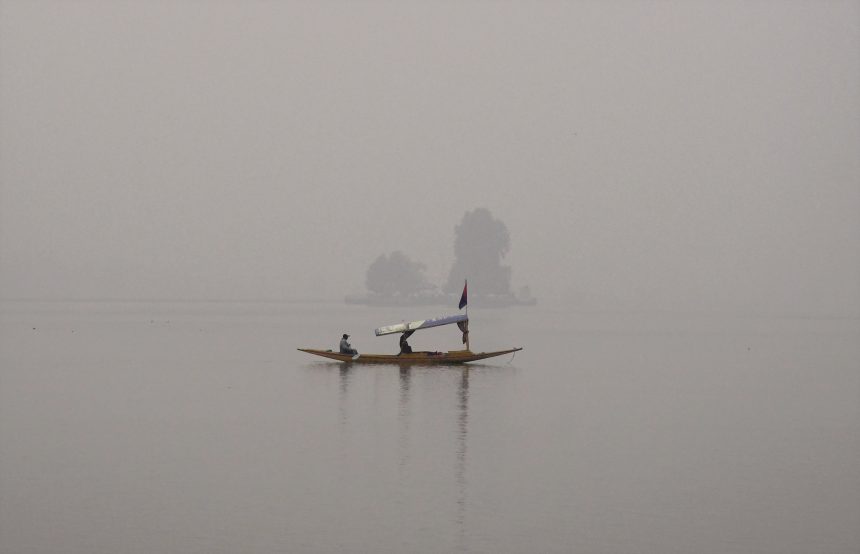Cold Grips Kashmir: Valley Shivers as Temperatures Plunge Below Freezing Point
By: Javid Amin | November 7, 2025
The chill of early winter has tightened its grip over the Kashmir Valley, sending temperatures tumbling below the freezing point across several regions. The cold wave has intensified, marking the onset of what promises to be a long and harsh winter season in the Himalayan region.
Mercury Dips Across the Valley
According to the latest weather reports from the Meteorological Department, Srinagar recorded a low of -1.4°C, its coldest night of the season so far. In Gulmarg, the famous ski resort in north Kashmir, temperatures plummeted to -4.8°C, leaving the meadows wrapped under a sheet of frost. Pahalgam, often called the “Valley of Shepherds,” registered -3.6°C, while the higher reaches of Sonamarg and Kupwara reported even colder conditions.
The cold has forced residents to dig out their traditional ‘Pherans’ (woollen cloaks) and ‘Kangris’ (earthen fire pots) — time-tested symbols of Kashmiri winter living.
First Signs of ‘Chillai Kalan’
Though ‘Chillai Kalan’, the 40-day harshest period of winter, officially begins on December 21, this year’s cold has arrived early. Frost-covered rooftops, frozen water pipes, and icy roads in the mornings are now becoming a familiar sight across the Valley.
Local meteorologists attribute the sudden temperature drop to clear night skies and dry continental winds blowing across the region. The absence of significant precipitation has also contributed to rapid heat loss after sunset.
“We are witnessing an early cold wave pattern this year. Night temperatures are dropping faster than expected, especially in central and north Kashmir,”
— an official from the Meteorological Centre, Srinagar.
Tourist Hotspots Turn Winter Wonderlands
While the cold has created challenges for locals, it’s a boon for the tourism sector. Gulmarg and Pahalgam are witnessing a gradual rise in tourist footfall as visitors from across India and abroad arrive to witness Kashmir’s snow-laden landscapes.
Hotels and resorts have started early winter promotions, offering packages around snow treks, skiing lessons, and photography tours. The J&K Tourism Department has also launched campaigns encouraging tourists to “Experience Kashmir in Winter” — highlighting the region’s breathtaking scenery and cozy winter culture.
Locals Brace for the Cold
The biting cold, however, has made daily life tough for residents. In rural areas, frozen taps and water lines have become common, while morning fog disrupts visibility on highways connecting Srinagar with Jammu. Power cuts have added to the woes, especially during peak evening hours when demand surges.
Shopkeepers in Lal Chowk, Srinagar’s commercial hub, have stocked up on winter essentials like woollens, heating appliances, and Kangri baskets. The prices of firewood and charcoal have also shot up in anticipation of prolonged cold days ahead.
“We are used to the chill, but this year it seems harsher already,”
says Mohammad Rafiq, a shopkeeper in downtown Srinagar.
“Our children are finding it difficult to get up early for school. The Kangri has become our best friend again.”
Weather Forecast: More Cold, Light Snow Expected
The Meteorological Department has predicted that the cold wave will continue over the next few days, with light snowfall likely in higher reaches such as Gulmarg, Kupwara, and Sonamarg. A brief spell of rain and snow could also hit parts of South Kashmir next week.
Officials have urged travelers and commuters to exercise caution on mountain roads due to the possibility of slippery surfaces and early-morning frost.
Cultural Warmth Amid the Cold
Despite the chill, winter in Kashmir brings with it a unique cultural warmth. The Samovar tea, Harissa breakfasts, and Kahwa gatherings mark the spirit of the season. Families spend evenings around kangris, sharing stories and warmth.
Artisans in downtown Srinagar begin work on hand-woven shawls, carpets, and woodcrafts, catering to both local demand and the winter tourist market. The scent of dry fish (Hokh) and turnip dishes fills homes — traditional delicacies that have long been part of Kashmir’s winter cuisine.
Impact on Daily Life and Transport
The sharp temperature drop has affected morning flight operations at Srinagar International Airport, with reports of slight delays due to fog and visibility issues. Roads in upper reaches like Tangmarg, Kupwara, and Gurez have developed thin ice layers, making travel tricky for motorists.
Local authorities have deployed de-icing teams and salt sprinklers in vulnerable areas. The Traffic Department has issued advisories urging drivers to maintain low speeds and avoid unnecessary travel in the early morning and late evening hours.
Electricity Woes Return
Power cuts have become a recurring complaint among residents. With heating needs rising sharply, electricity consumption has surged. The Power Development Department (PDD) has appealed for judicious use of electricity, especially during peak hours.
Several localities in Srinagar, Pulwama, and Budgam faced unscheduled outages, prompting public frustration. The department, however, assured that load-balancing efforts were being made and that additional transformers were being installed to prevent system overload.
Tourism Industry Eyes Opportunity
For the tourism sector, the cold brings optimism. Winter adventure sports — skiing, snowboarding, snowshoeing — are expected to attract both domestic and international tourists. Hoteliers in Gulmarg are gearing up for the 2025 Snow Festival, scheduled for late December, featuring local cuisine stalls, music events, and ski races.
The tourism department expects the season to generate significant revenue, as early snow could extend the skiing window up to February.
Bottom-Line: Winter’s First Act
The cold that now grips Kashmir is more than a weather phenomenon — it’s a reminder of the Valley’s unique rhythm, where nature’s chill coexists with human warmth. As temperatures continue to fall, life in Kashmir adjusts — not with despair, but with resilience, woollens, kangris, and an undying love for tea and togetherness.
The season of frost has just begun, and for the people of the Valley, each winter tells its own story — of endurance, adaptation, and timeless beauty.



